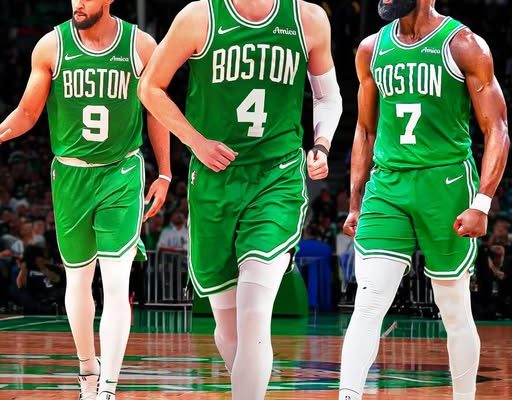In the rapidly shifting terrain of the NBA, franchises must walk a delicate tightrope between remaining competitive and managing long-term financial flexibility. The Boston Celtics, after a year that brought them a long-awaited championship behind the brilliance of Jayson Tatum, Jaylen Brown, and a seasoned supporting cast, now face a sobering reality. Tatum is sidelined for the year with a lower-body injury. That seismic blow alone could have warranted a complete pivot in strategy. But when combined with Boston’s staggering payroll—teetering near half a billion dollars once luxury taxes are factored in—the organization found itself at a turning point. The 2025 offseason, rather than being one of simple retooling, has turned into a calculated restructuring. While fans may have winced at the departures of seasoned contributors like Jrue Holiday and Kristaps Porziņģis, those moves signal something far more profound: the Celtics are plotting for the long term. The decision-makers in Boston are preparing for a two-year detour around the league’s most punishing financial thresholds, with an eye toward resetting the repeater tax penalties and returning stronger. And perhaps the most underrated move in this strategic shuffle? The acquisition of Walker Kessler, a quiet coup that might come to define Boston’s summer.
Kessler, at just 24 years old, offers a rare blend of attributes: elite rim protection, positional versatility, and a contract that is almost too good to be true. These are the kinds of players championship teams crave, especially when navigating tight financial waters. With the Celtics’ budget stretched to the brink, finding players on rookie-scale deals who can contribute meaningfully is no longer a luxury—it’s a necessity. Kessler is entering his third NBA season after two productive years in Utah. He’s already established himself as one of the league’s most dependable shot-blockers, and his advanced metrics suggest he’s just scratching the surface. While he may never be the type of big who can run an offense or stretch the floor from deep, his defensive value, rebounding prowess, and low-maintenance offensive game make him an ideal fit alongside high-usage stars like Brown and White.
Boston’s front office understood the assignment. Executing a three-team deal involving Utah and Miami, the Celtics sent Anfernee Simons—who they had acquired in a prior transaction—and Neemias Queta, plus a collection of picks and cash, in exchange for Kessler. But the brilliance of the deal doesn’t stop at basketball. The trade also generated a \$27.7 million trade exception, giving Boston a massive tool for future flexibility. Those exceptions often go unused or are misapplied around the league, but in the hands of Boston’s sharp executives, it could turn into a midseason acquisition or a future draft-day swing. The Celtics didn’t just acquire a player—they gave themselves breathing room, options, and a potential star on a controllable deal.
In the immediate term, Kessler provides cover at the five, where the Celtics had a glaring hole after moving off Porziņģis. Al Horford remains on the roster, but at 39 years old, the veteran can’t be expected to anchor the center position for extended minutes or a full season. Kessler gives the Celtics a starting-caliber option, someone who can defend the rim, switch on the perimeter when necessary, and clean the glass. Offensively, his game is simple but effective—dunks, lobs, and short rolls. With Boston’s guards and wings doing the heavy lifting on scoring, Kessler’s low-usage style complements rather than clashes. His screens open up driving lanes, and his vertical gravity adds a dimension that was missing in many of Boston’s lineups last year.
But perhaps the most exciting element of this acquisition is what it says about Boston’s broader plan. Rather than clinging desperately to the remnants of their title roster, they’re pivoting with discipline. Teams often fall into the trap of sentimentality after winning it all, overpaying to keep core players together or chasing one more run even when the writing is on the wall. Boston isn’t doing that. They’re charting a path that allows for sustained success—keeping their stars while surrounding them with younger, cheaper, and more malleable pieces. Kessler is extension-eligible now, but the Celtics can simply wait. If he performs as expected, they can match any restricted free agency offer next summer. It’s low risk, high reward, and the kind of maneuver that could pay massive dividends if Kessler becomes the rim-protecting anchor they believe he can be.
From a cap management standpoint, this move is masterful. Boston needed to trim roughly \$100 million in projected payroll and taxes to avoid deeper financial penalties. Shedding Holiday and Porziņģis was just the first domino. With Kessler’s contract still on his rookie deal and no long-term commitment necessary just yet, the Celtics have positioned themselves to reset their books without bottoming out. They can still compete. White, Brown, and other role players give them enough firepower to stay relevant in the East, especially if Kessler blossoms and they find value with their trade exception. And when Tatum returns healthy, this could be a team loaded with youth, financial flexibility, and still the star power to contend. The Celtics aren’t just trying to survive Tatum’s absence—they’re setting themselves up to thrive beyond it.
Walker Kessler isn’t flashy. He doesn’t dominate highlight reels or ignite viral debates on NBA Twitter. But what he brings is stability, defense, and upside—all wrapped in an economical package. On a team like Boston, flush with scoring talent and strategic vision, Kessler could emerge as the type of player whose value far exceeds his salary. And make no mistake: this was a shrewd move made with the future in mind. For a franchise that’s trying to balance the twin goals of contention and cap discipline, Kessler might be the ideal acquisition. The fact that he’s 24 and already experienced in starting roles only sweetens the deal. Players like this don’t become available often, and rarely at such a manageable price.
There’s also a culture component that shouldn’t be overlooked. Kessler, by all accounts, is a team-first player with a strong work ethic. He brings no ego, no drama—just a desire to improve and contribute. That fits perfectly into Boston’s locker room, especially in a transitional year where cohesion and development will be emphasized over immediate results. While the Celtics still plan to compete, they understand this isn’t the year to go all-in. Instead, it’s a year to experiment, develop, and clear the books. Kessler can play 28–30 minutes per night, mentor younger players, and establish himself as a defensive centerpiece. If he exceeds expectations, Boston wins the trade outright. If he simply meets them, he’s still a net positive and a future trade asset. That kind of flexibility is invaluable in today’s NBA.
For fans, it’s tempting to focus on what’s lost. The departures of key veterans and the injury to Tatum might seem like the beginning of a decline. But that would be a mistake. What’s actually happening is more akin to a software update. The Celtics aren’t blowing it up—they’re optimizing. They’re acknowledging the economic realities of a new CBA era, adjusting their formula, and building in a way that keeps their championship window open. Kessler is a part of that vision, not just for this year, but for what comes after. When Tatum returns, when the books are clean, and when Boston is ready to strike again with cap space and youth, Kessler may be one of the key reasons they’re in a position to do so.
Every summer brings a few moves that fly under the radar, only to be re-evaluated months later as genius. This could be one of them. Walker Kessler’s arrival in Boston didn’t dominate headlines, but it may ultimately be the pivot point of the Celtics’ next era. He offers more than just numbers—he offers a blueprint. And as Boston reshapes its roster with a nod to both present functionality and future dominance, Kessler stands at the center—literally and symbolically. What he does in a green jersey this season may not only help the Celtics navigate this transitional phase but also set them up for another sustained run at the top of the league. In an offseason full of calculated gambles and fiscal acrobatics, this move could go down as the most important chess move of them all.



